
Plant Profiles
Click on the first letter of the common name of the plant you wish more information about.
A | B | C | D | E | F | G | H | I | J | K | L | M | N | O | P | Q | R | S | T | U | V | W | X | Y | Z
A
- Aeschynanthus
- African Iris
- Ageratum
- Alternanthera
- Aluminum Plant
- Amaryllis
- American Hop Hornbeam
- Angelonia
- Anise
- Annual Phlox
- Ascocenda Orchid
- Australian Violet
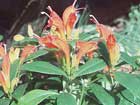
Aeschynanthus
Scientific Name: Aeschynanthus hybrid.
Growth Habit: A semi-trailing to trailing evergreen perennial growing shoots to more than 2 feet long. The leaves are bright green and lance-shaped, growing to 4 inches long and 1 inch wide.
Light: Provide a high light location, but protect from all but filtered or early morning sun.
Feedings: Apply a houseplant product monthly during periods of active growth March through November; no fertilizer is needed during the winter months.
Water Needs: Allow the surface soil to dry between waterings. Plants grow best in a humid atmosphere; mist frequently during hot, dry weather.
Ease of Culture: Easy.
Propagation: Start plants from 4- to 6-inch tip cuttings.
Hardiness: Tender; grow as a houseplant year-round or patio plant when temperatures are above 50 degrees.
Major Problems: Aphids and mealybug; wash off with a soapy water solution or apply an insecticidal soap spray. Avoid overwatering during the cooler weather to prevent root rot.
Pruning: Periodically tip back the ends of shoots of young plants to cause branching and additional flowers. Groom plants as needed to remove extra-long shoots and produce uniform displays.
Uses: An attractive foliage plant to display indoors in a hanging basket or planter during the winter months. Use outdoors suspended from rafters, overhangs and tree limbs spring through early fall. Plants produce terminal flower clusters of tubular-shaped orange blossoms July through March to contrast with the bright green waxy foliage.
Florida Native: No; a hybrid with parentage from Malaysia.
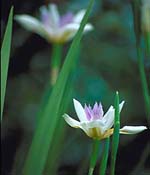
African Iris
Scientific Name: Dietes bicolor
Growth Habit: An upright, clump-forming evergreen perennial with foliage arising from rhizomes at ground level. The leaves are lancelike, forming the clumps that grow to 2 feet tall and a foot wide.
Light: Grow in full sun to lightly shaded locations.
Feedings: Seldom needs special feedings; where needed growth can be increased with a general garden fertilizer application once monthly in March, June and September.
Water Needs: Drought tolerant; can survive with seasonal rains but grows best with waterings every 10 to14 days.
Ease of Culture: Easy.
Propagation: From seeds or by dividing older clumps.
Hardiness: Hardy; some leaf damage may occur during severe freezes.
Major Problems: Chewing insects occasionally damage the foliage, but controls seldom are needed. Plant in well-drained soils to avoid root rot problems.
Pruning: Remove declining foliage and old seed heads as needed throughout the year. Trim away cold-damaged foliage, and reduce the clump size if needed during late winter.
Uses: Cluster several clumps to form a durable ground cover. Plantings are especially useful in dry locations and sunny spots where grass is difficult to grow. Use along walkways, in foundation plantings and as part of a perennial garden. Bright yellow flowers with dark spots near the center are produced during all but the coldest months.
Florida Native: No; native to South Africa.
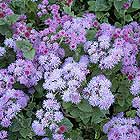
Ageratum
Scientific Name:Ageratum houstonianum
Growth Habit: A sprawling, long-lived annual growing to 2 feet tall and almost as wide. The leaves are bright green and heart-shaped, growing to 2 inches long and an inch wide.
Light: Plant in full-sun locations.
Feedings: Apply a general garden fertilizer monthly to in-ground plantings; feed container plantings with a 20-20-20 or similar fertilizer solution every other week. A slow-release fertilizer also can be used following label instructions.
Water Needs: Prefers a moist soil; water when the surface begins to dry.
Ease of Culture: Easy.
Propagation: Start plants from seed.
Hardiness: Tender; protect from frosts and freezes.
Major Problems: Chewing pests including caterpillars and slugs may damage foliage. Handpick or apply a natural control. Garden flea hoppers often cause a yellow dotting of the leaves and can be controlled with a natural pyrethrin spray.
Pruning: Keep in bounds by removing extra-long portions of sprawling shoots as needed. Trim off cold injury.
Uses: An attractive temporary ground cover developing a carpet of blue, purple or white blooms depending on the variety. Plants can be in flower October through July provided they are not affected by cold during the winter months. Ageratum also can be used in borders with a backdrop of other taller greenery or flowers. Also add to container gardens or hanging baskets where they can cascade over the sides.
Florida Native: No; native to Mexico, Guatemala and Honduras.
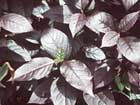
Alternanthera
Scientific Name: Alternanthera dentata 'Purple Knight'
Growth Habit: An evergreen multi- stemmed perennial growing to 24 inches tall and 36 inches wide. The leaves are broadly lance-shaped, deep green to purple and growing to 6 inches long and 3 inches wide.
Light: Plant in full-sun to lightly shaded locations.
Feedings: Apply a general garden fertilizer monthly to encourage growth of in-ground plantings, every other month to maintain established plants. Feed container plantings every other week during the warmer months.
Water Needs: Tolerates short periods of drought, but in-ground plantings grow best with weekly waterings; container plantings may need daily waterings during hot, dry weather.
Ease of Culture: Easy.
Propagation: Start plants from seeds or cuttings.
Hardiness: Tender; grow in containers so plants can be moved to a warmer location or cover in-ground plantings to protect from frosts or freezes.
Major Problems: Caterpillars and slugs like the tender leaves. Handpick and destroy or control with a natural pesticide.
Pruning: Plantings grow rapidly during the warmer months and may encroach upon nearby perennials or shrubs. Trim back as needed to control growth. Also tip back vigorous shoots during the growing season to cause branching and produce more compact plants.
Uses: Purple Knight is a new variety of the popular alternanthera, sometimes called Joseph's coat. It's often planted as a border or a ground cover.
Florida Native: No; native to the West Indies and Brazil.
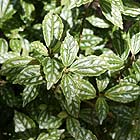
Aluminum Plant
Scientific Name: Pilea cadierei
Growth Habit: A sprawling perennial growing to 18 inches tall and twice as wide. The leaves are shiny green with silvery blotches and grow to 3 inches long and about half as wide.
Light: Plant in shade to filtered-sun locations.
Feedings: Apply a general garden fertilizer to in-ground plantings once monthly in March, June and September. Feed container-grown plants monthly, March through November.
Water Needs: Tolerates short periods of drought; grows best if watered once a week during hot, dry weather.
Ease of Culture: Easy.
Propagation: Start plants from cuttings.
Hardiness: Tender; survives most winters under trees and overhangs with some stem damage.
Major Problems: Mites may attack the foliage, causing yellowing and leaf drop. Control with a soap spray as needed.
Pruning: Keep plants in bounds by periodically trimming off sprawling shoots. Remove cold-damaged stems and reshape plantings to begin spring growth during March.
Uses: An underused ground cover that adds the tropical look to shady landscapes. Plants are easy to grow and offer attractive silvery foliage. Small white clusters of flowers also are produced among the foliage during the summer months. Plants also are used individually or in combination with other shade-loving foliage plants in container gardens to decorate balconies and patios. A small-leaf form is also available.
Florida Native: No; native to Vietnam.
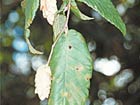
American Hop Hornbeam
Scientific Name: Ostrya virginiana
Growth Habit: An upright to pyramidal tree when young, gradually taking a rounded shape with age and growing to 25 feet tall and wide. The leaves are deciduous and oblong, growing to 4 inches long with finely toothed edges.
Light: Plant in full-sun to lightly shaded locations.
Feedings: Fertilize lightly once monthly in March and June with a general garden fertilizer for the first three years after planting. Once established, the tree obtains needed nutrients from decomposing mulches and nearby feedings of shrubs and lawns.
Water Needs: Drought tolerant. Water when young to establish the root system in the surrounding soil; thereafter, the tree usually survives with seasonal rains.
Ease of Culture: Easy.
Propagation: Start trees from seed.
Hardiness: Hardy.
Major Problems: During the rainy summer season, the foliage develops leaf spots that are unsightly, but no sprays are needed. Plant in well-drained soils to avoid root-rot problems.
Pruning: Train to a single or multiple trunk tree, removing suckers and competing limbs until the tree is 6 to 8 feet tall. Then allow branching to form a rounded crown. Remove lower limbs as needed to allow movement along walkways and maintenance under the canopy.
Uses: Plant as a small shade tree for patios and along walkways. Trees also can be used as backdrops for gardens and as street trees. The flowers are brown and green but not showy. An attractive pale green, hoplike, papery capsule forms during the summer and matures a golden brown color by early fall to provide food for wildlife. The tree adds the Northern temperate climate look to local landscapes with attractive, often reddish shredding bark and leaves turning a yellow color for fall.
Florida Native: Yes.
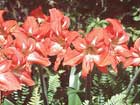
Amaryllis
Scientific Name: Hippeastrum hybridum
Growth Habit: A perennial with long straplike leaves arising from a large bulb with a neck protruding a few inches above the soil line. Leaves are dark green, often arching, with parallel veins growing to 2 feet long.
Light: Plant in full sun to light shade.
Feedings: Apply a general garden fertilizer every six to eight weeks March through August.
Water Needs: Tolerates short periods of drought but grows best with weekly waterings February through September. During the fall and winter months allow the soil to dry between waterings to encourage spring blooms.
Ease of Culture: Easy.
Propagation: Start plants with seed or by dividing older clusters of bulbs.
Hardiness: Hardy; tops may be damaged by frosts or freezes, but plants survive as bulbs protected by mulches and soil.
Major Problems: Large lubber grasshoppers love the foliage and should be handpicked from the plants when young each spring. Plantings are also affected by red blotch, a disease causing brown to red spots on the leaves. Prune light infections or treat with a fungicide when severe.
Pruning: Amaryllis need minimal pruning except as required to remove damaged leaves and foliage affected by cold. When needed, longer leaves can be trimmed from walkways and nearby plants.
Uses: Add amaryllis to perennial flower beds and to create spots of color among shrub plantings. They can also be used in container gardens to set on porches and patios when in bloom. Bulbs are available to produce red, orange or white trumpet-shaped blooms that rise well above the foliage during March and April.
Florida Native: No; hybrids produced with species from South America.
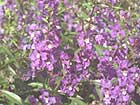
Angelonia
Scientific Name: Angelonia angustifolia
Growth Habit: An evergreen upright perennial with numerous stems growing to 24 inches tall and wide. The leaves are sparingly toothed, bright green and lancelike and growing to 4 inches long and 3/4-inch wide.
Light: Plant in full-sun locations.
Feedings: Apply a general garden fertilizer every other month March through November.
Water Needs: Prefers a moist soil; water at least weekly.
Ease of Culture: Easy.
Propagation: Start plants from seeds or cuttings.
Hardiness: Tender; protect from freezing weather. May survive freezes, growing back from buds near the ground.
Major Problems: Plant in well-drained soils to avoid root-rot problems. Foliage may be damaged by chewing insects, but a control is seldom needed.
Pruning: Remove old flower heads as they begin to decline. Trim stems that become floppy and interfere with nearby flowers or ground covers. May also be sheared back as needed to encourage branching and a more compact growth habit.
Uses: Angelonia plantings appear to grow best in Florida during the warmish weather fall through spring. Cluster in flower beds to enjoy the spikes of blue, purple, pink, white and bicolor blossoms that last for weeks. Angelonia can be added to container gardens for balconies and patio displays. Stems of blooms also can be cut for bouquets.
Florida Native: No; native to Mexico and the West Indies.
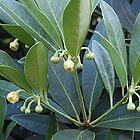
Anise
Scientific Name: Illicium parviflorum
Growth Habit: An evergreen shrub with dense foliage to the ground and an upright to rounded shape; grows to 12 feet tall and 8 feet wide. The leaves are a medium-green color and lancelike in shape, growing to 6 inches long and 2 inches wide.
Light: Plant in full-sun to shady.
Feedings: Apply a general garden fertilizer once monthly in March, June and September if needed to encourage growth.
Water Needs: Tolerates short periods of drought; grows best when watered every seven to 10 days.
Ease of Culture: Easy.
Propagation: Start plants from cuttings.
Hardiness: Hardy.
Major Problems: Scale insects occasionally may attack the stems and foliage. When needed, a low-toxicity oil spray can be applied as a control.
Pruning: Encourage dense growth by removing the growing tips as needed to produce additional branches with foliage. The plants grow tall and may need the selective removal of individual stems to control height and width in late winter and midsummer. Shearing is not recommended because the leaves are large and show the pruning wounds.
Uses: An excellent hedge plant for sun and shade. Plantings make an excellent backdrop for smaller shrubs and flower beds or can be used to create view barriers. They also can be trained to form small trees for patios and along walkways. The leaves have an anise fragrance when crushed. Small, yellowish, bell-like flowers are produced during May and June but are not very showy.
Florida Native: Yes.
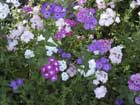
Annual Phlox
Scientific Name: Phlox drummondii
Growth Habit: A multistemmed upright-to-spreading annual growing to 18 inches tall and 24 inches wide. The leaves are oblong and medium green and grow to 3 inches long and 1 inch wide.
Light: Plants prefer full sun but tolerate light shade.
Feedings: Tolerates poor soils. Best growth comes with light monthly feedings of a general garden fertilizer.
Water Needs: Phlox plants are drought tolerant and can survive with seasonal rains. Newer selections appear to grow best with weekly waterings during hot, dry times.
Ease of Culture: Easy.
Propagation: Start plants from seed. Plants may reseed from one year to another.
Hardiness: Hardy.
Major Problems: Grow in well-drained soils to prevent root-rot problems during damp weather. Plants may be affected by powdery mildew during the spring months but seldom need a control.
Pruning: Trim spreading selections as needed to prevent the plants from encroaching upon other flowers. Remove declining blooms to encourage additional flowers.
Uses: Trim spreading selections as needed to prevent the plants from encroaching upon other flowers. Remove declining blooms to encourage additional flowers.
Florida Native: No; native to Texas.
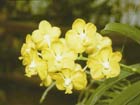
Ascocenda Orchid
Scientific Name: Ascocenda hybrid
Growth Habit: An upright to sprawling orchid growing to 18 inches tall and wide. The leaves are straplike and medium green and grow to 6 inches long and an inch wide.
Light: Grow in a filtered-sun location.
Feedings: Apply a 20-20-20 or orchid fertilizer every other week during the warmer months, once a month during the cooler weather.
Water Needs: Moisten daily to every other day during the hot, dry weather; water when the plants or growing medium dries during the cooler months.
Ease of Culture: Easy.
Propagation: Remove offshoots during the spring months to continue growth in pots or baskets.
Hardiness: Tender; keep from freezing. The best growth is obtained when plants are kept above 55 degrees.
Major Problems: Gardeners may encounter root rot and leaf spot problems. These fungal diseases can be prevented by providing good air movement and following a good care program.
Pruning: Remove old leaves and flower stems as they begin to decline. Avoid removing the aerial roots that extend down from the stems. These are used to obtain water and nutrients for growth.
Uses: An exotic accent plant to hang under a tree or lath structure during the warmer months. Display the orchids where they can be seen easily near patios, in gardens and along walkways. Clusters of blooms open throughout the year in white, yellow, orange, red or purple colors depending on the varieties. The plants also can be grown in a bright window or a shaded greenhouse.
Florida Native: No; a hybrid of plants from Burma, India and the Philippines.
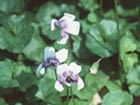
Australian Violet
Scientific Name: Viola hederacea
Growth Habit: A creeping evergreen perennial spreading from shoots near the ground line producing plants up to 6 inches tall and more than a foot wide. The bright green leaves are kidney-shaped and up to an inch long and wide.
Light: Plant in full-sun to shady locations.
Feedings: Apply a general garden fertilizer once monthly in March, June and September.
Water Needs: Prefers a moist site; grows best with weekly waterings.
Ease of Culture: Easy.
Propagation: Divide older clumps.
Hardiness: Hardy; top portions are damaged by severe freezes, but plants grow back from stems at or below the soil surface. Plantings protected by trees and shrubs are seldom damaged by cold.
Major Problems: Slugs can produce holes in the leaves; they hide in the moist areas under the foliage. Try to handpick or use a shallow container of beer or a malt beverage to trap the pests.
Pruning: Plantings produce lots of runners and may invade nearby flowers and shrubs. Keep the plants in bounds by periodically edging beds and walkways. After a freeze, rake out cold-damaged foliage.
Uses: Home gardeners are just discovering the Australian violet for use as a ground cover in the lower light locations. It's a good plant to fill areas where the grass won't grow, providing an almost constant display of white blossoms with a central lavender blotch held well above the foliage March through November. Plants also can be used to fill pots or placed in a hanging basket where the stems trail down over the sides.
Florida Native: No; native to Australia.